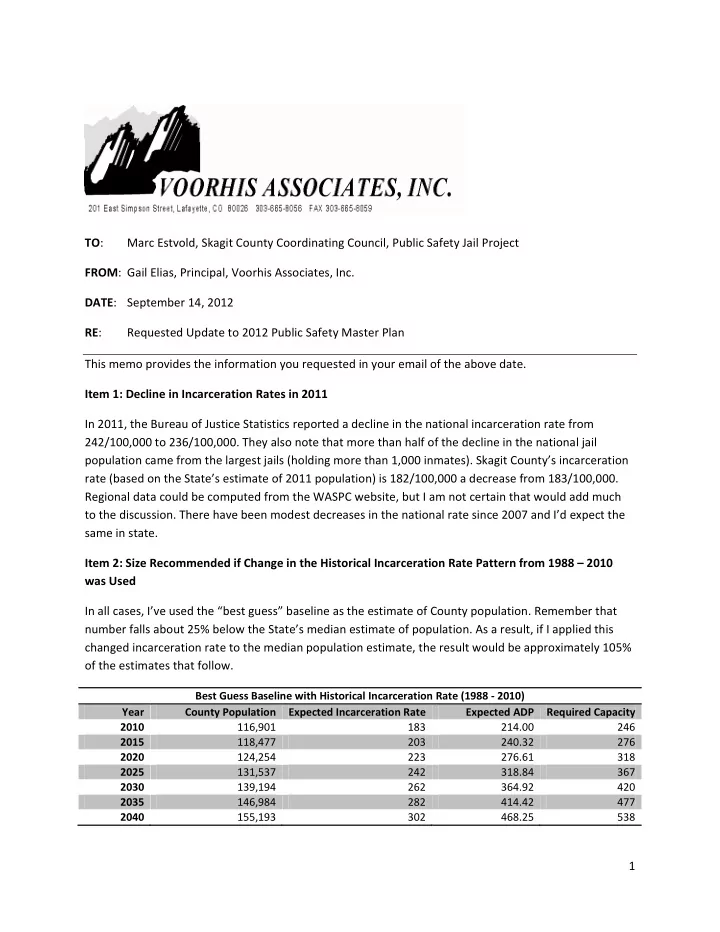

TO : Marc Estvold, Skagit County Coordinating Council, Public Safety Jail Project FROM : Gail Elias, Principal, Voorhis Associates, Inc. DATE : September 14, 2012 RE : Requested Update to 2012 Public Safety Master Plan This memo provides the information you requested in your email of the above date. Item 1: Decline in Incarceration Rates in 2011 In 2011, the Bureau of Justice Statistics reported a decline in the national incarceration rate from 242/100,000 to 236/100,000. They also note that more than half of the decline in the national jail population came from the largest jails (holding more than 1,000 inmates). Skagit County’s incarceration rate (based on the State’s estimate of 2011 population) is 182/100,000 a decrease from 183/100,000. Regional data could be computed from the WASPC website, but I am not certain that would add much to the discussion. There have been modest decreases in the national rate since 2007 and I’d expect the same in state. Item 2: Size Recommended if Change in the Historical Incarceration Rate Pattern from 1988 – 2010 was Used In all cases, I’ve used the “best guess” baseline as the estimate of County population. Remember that number falls about 25% below the State’s median estimate of population. As a result, if I applied this changed incarceration rate to the median population estimate, the result would be approximately 105% of the estimates that follow. Best Guess Baseline with Historical Incarceration Rate (1988 ‐ 2010) Year County Population Expected Incarceration Rate Expected ADP Required Capacity 2010 116,901 183 214.00 246 2015 118,477 203 240.32 276 2020 124,254 223 276.61 318 2025 131,537 242 318.84 367 2030 139,194 262 364.92 420 2035 146,984 282 414.42 477 2040 155,193 302 468.25 538 1
The change in incarceration rate using this model is just under 4 inmates per 100,000 per year. It does result in a lower ADP and reduced capacity. Looking at the 2015 expected ADP and capacity requirements, the only caution I would note is that the County’s 2009 in ‐ facility ADP was 237 and ADP under supervision exceed 250. Best Guess Baseline with Reduced Incarceration Rate (1988 ‐ 2010) Year County Population Expected Incarceration Rate Expected ADP Required Capacity 2010 116,901 183 214.00 246 2015 118,477 199 235.57 271 2020 124,254 215 266.65 307 2025 131,537 230 303.03 348 2030 139,194 246 342.62 394 2035 146,984 262 384.98 443 2040 155,193 278 430.96 496 I have the same concern about this model. Item 3: Size Recommended if Change in the Historical Incarceration Rate Pattern from 1988 – 2003 was Used Best Guess Baseline with Historical Incarceration Rate (1988 ‐ 2003) Year County Population Expected Incarceration Rate Expected ADP Required Capacity 2010 116,901 183 214.00 246 2015 118,477 207 245.28 282 2020 124,254 231 287.02 330 2025 131,537 255 335.37 386 2030 139,194 279 388.25 446 2035 146,984 303 445.21 512 2040 155,193 327 507.27 583 This model results in an annual change of the incarceration rate of 4.79 inmates per 100,000. Best Guess Baseline with Reduced Incarceration Rate (1988 ‐ 2003) Year County Population Expected Incarceration Rate Expected ADP Required Capacity 2010 116,901 183 214.00 246 2015 118,477 202 239.60 276 2020 124,254 221 275.11 316 2025 131,537 241 316.45 364 2030 139,194 260 361.56 416 2035 146,984 279 409.98 471 2040 155,193 298 462.64 532 2
Incarceration Rate 2030 Housing 2040 Core Forecast Model Pattern Capacity Capacity 1 Baseline ‐ Low Population Estimate 1984 ‐ 2010 407 523 2 Baseline ‐ Median Population Estimate 1984 ‐ 2012 483 643 3 Baseline ‐ High Population Estimate 1984 ‐ 2013 600 833 4 Baseline ‐ "Best Guess" Population Estimate 1984 ‐ 2011 464 613 Lower Incarceration Rate ‐ "Best Guess" 5 Population Estimate 1984 ‐ 2014 431 557 6 Baseline ‐ "Best Guess" Population Estimate 1988 ‐ 2010 420 538 Lower Incarceration Rate ‐ "Best Guess" 7 Population Estimate 1988 ‐ 2010 394 496 8 Baseline "Best Guess" Population Estimate 1988 ‐ 2003 446 583 Lower Incarceration Rate ‐ "Best Guess" 9 Population Estimate 1988 ‐ 2003 416 532 Recommended 2012 428 600 The above table compares the four new scenarios with the five previously developed and included in the 2010 master plan update. When developing estimates of future population, it is very easy to get focused on a specific point in time – and a specific number that is perceived as the “right” number. In my experience, it is more productive to think of these estimates as establishing a range within which the true “right” number can be found. 1) If I apply that approach, the nine scenarios establish a 2030 housing capacity range from a low of 394 – 600 and a 2040 core range of 496 – 833. 2) As I suggested yesterday, scenarios 1 (Baseline ‐ Low Population Estimate) and 3 (Baseline ‐ High Population Estimate) do not seem realistic to me. If I exclude those, then the 2030 housing capacity range falls between 394 and 483 and the 2040 core ranges between 496 and 543. 3) The 428 housing capacity recommended lies approximately halfway between the remaining estimates. I continue to think that this number makes sense because it is built around the most efficient staffing pattern we developed. 4) I also think the core that I’ve suggested makes sense because it gives the County greater flexibility. I 3
Recommend
More recommend